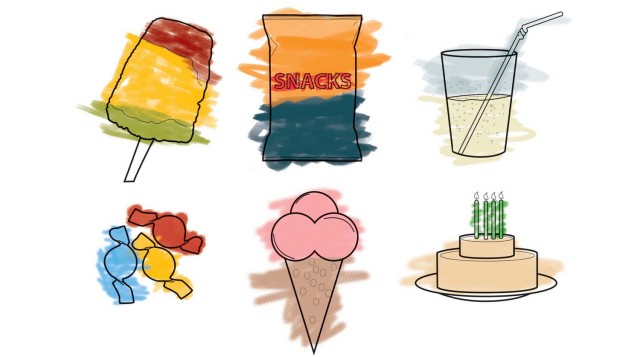
Pakistan Pure Food Rules permit the use of 18 food-grade colourants but food sellers avoid using them because they are expensive. The legal stuff costs Rs100 per kilogramme. In Jodia Bazaar, one vendor explained that FDA-approved food colours used to be much more expensive at about Rs400 but now cheaper colours from India and China cost Rs100 per kg. The next best thing are the low quality but toxic colours or textile dyes at Rs20 per kg.
A recent study by the Pakistan Council of Scientific and Industrial Research (PCSIR) revealed that the use of textile dyes such as yellow, red, blue and black has gone up 90 per cent in certain branded and unbranded food items.
“Colourants are widely used in the food industry to enhance the appearance of food products, but in Pakistan the use is unusually high,” said Askari Begum, director of planning and development at the PCSIR. “Approximately 90 per cent of our food products are manufactured by using synthetic colours that are carcinogenic or cancer causing. They can provoke asthma attacks, allergic reactions, kidney tumours and high blood pressure,” she said quoting the research by PCSIR microbiologists from late 2006.
For the study, which focused on children’s eating habits, a total of 841 samples of coloured food items were collected from 490 educational institutes across Karachi. These samples included branded items inside school canteens and unbranded ones sold by vendors outside schools. Out of the 410 unbranded food items, 182 were found unfit for human consumption. The children were eating mithai and gola ganda. They were also buying ice lollies that were coloured red, non-branded or fake soft drinks coloured black. Men were selling biryani and bakery products that were enhanced with yellow and orange dyes. Even chewing gum and and ice cream were all found to contain non-food grade colours
The study also revealed severe degenerative changes in the liver, leading its authors to conclude that the use of textile dyes in food can have a toxic effect on vital organs in humans.
Apart from sharing their findings at a seminar, the PCSIR sent a copy of the research and recommendations to the relevant health departments and regulatory authorities, but three years have passed and nothing has been done.
Children suffer the worst, say health experts, as the regular consumption of coloured food stuffs affects their concentration levels and can cause learning difficulties. In other cases, those allergic to artificial colours suffer more as they are deposited in the body. “Heavy metals such as lead, copper, chromium and arsenic, which are found in sweets and snacks coloured with non-food grade dyes, are worse as they are not excreted,” explains one of the microbiologists who conducted the study.
Consumer activists insist that manufacturers who use non-food grade dyes should be brought to book under the Pakistan Pure Food Rules, but like many other laws, food laws are poorly enforced. “It is due to the incompetent food inspectors - who are supposed to be vigilant - that banned textile dyes find an illegal entry into the market,” says Kaukab Iqbal, chairman of the Consumer Association of Pakistan.
But these inspectors cite their own problems. “We are accused of being corrupt and incapable of combating this practice despite the presence of a law, but our problem is getting hold of witnesses who refuse to come to the courts,” argued Nadeem, a government food inspector.
The punishment for selling adulterated food is a two-year imprisonment under the Pakistan Pure Food Rules, but most often offenders get away with paying a fine of Rs5,000 to Rs50,000 before the judicial magistrate in the absence of a declaration by witnesses. “Although a declaration by the food inspector should be enough, the court doesn’t agree,” adds Nadeem.
Part of the responsibility lies with schools as well, argues Kaukab Iqbal. “If schools in affluent parts of the city are able to restrict vendors, why can’t schools in low-income areas do the same? It is difficult for parents to exercise this caution because they can’t monitor what their child eats during school hours.”
On the other hand, the regulatory body Pakistan Standards and Quality Control Authority (PSQCA) whose main function is to promote standards, ensure the health and safety of consumers, says it is helpless because issues relating to ‘unbranded products’ fall outside its mandate. “Food sold by vendors is not part of our list of 78 compulsory items whose standards need to be approved by the PSQCA,” said spokesman Rehmatullah Memon.
“This attitude is disappointing,” says Askari Begum. “It shows that higher ups are not interested in improving the quality of food products meant for the low income population of the country. Compromising the health of these people to serious diseases is resulting in an indirect financial burden on the national economy. The government must realise this.”
Published in The Express Tribune, June 21st, 2010.

1732437695-0/drake-and-charles-(1)1732437695-0-165x106.webp)


1732434981-0/BeFunky-collage-(10)1732434981-0-165x106.webp)












COMMENTS (1)
Comments are moderated and generally will be posted if they are on-topic and not abusive.
For more information, please see our Comments FAQ